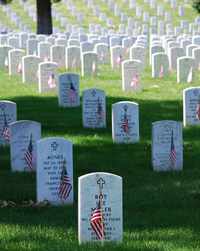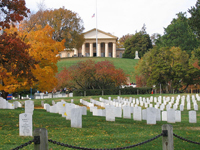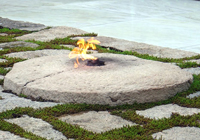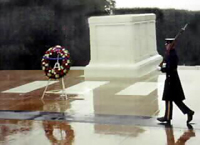Adventures at Arlington Cemetery
This post is part 10 of our Wednesday Adventure Series. Each week we will highlight something different in the Washington, D.C., Metro Area, many of which will be options for part of your own BookCrossing Journey. With so many things to see and do, how will you choose?
REMINDER: The last day to purchase registration at the cheapest price is December 31 and the first special deal expires on that day as well. Register today to get the best deal available!
 Arlington National Cemetery in Arlington, Virginia, was established during the Civil War and has a rich history as well as an important presence in the Washington, D.C. Metro area. The land was previously inhabited by Robert E. Lee and his family, inherited through his wife, Mary Anna Custis Lee (who, incidentally, was the great-granddaughter of Martha Washington, wife of the first President). Though President Abraham Lincoln offered Lee command of the Union army, Lee declined and, after Virginia seceded, became commander of the Confederate army. Since Arlington was so close to the Union border, Lee took his family further south to keep them safe.
Arlington National Cemetery in Arlington, Virginia, was established during the Civil War and has a rich history as well as an important presence in the Washington, D.C. Metro area. The land was previously inhabited by Robert E. Lee and his family, inherited through his wife, Mary Anna Custis Lee (who, incidentally, was the great-granddaughter of Martha Washington, wife of the first President). Though President Abraham Lincoln offered Lee command of the Union army, Lee declined and, after Virginia seceded, became commander of the Confederate army. Since Arlington was so close to the Union border, Lee took his family further south to keep them safe.
 When the government demanded payment of property taxes, Mrs. Lee sent an agent with the money. However, because she wasn’t there in person, the agent was refused, and the government acquired the estate. Shortly thereafter, Union soldiers moved in and established a fort. When the number of Civil War casualties grew faster than local cemeteries could accommodate, General Montgomery C. Meigs, who was stationed at the Lee mansion known as Arlington House, proposed a new cemetery be established there. His intention was to make the property uninhabitable should the Lees ever return. In 1863, Freedman’s Village was established, where freed slaves lived and farmed during and after the Civil War. However, they were turned out in 1890 when the government rededicated the land as a military installation.
When the government demanded payment of property taxes, Mrs. Lee sent an agent with the money. However, because she wasn’t there in person, the agent was refused, and the government acquired the estate. Shortly thereafter, Union soldiers moved in and established a fort. When the number of Civil War casualties grew faster than local cemeteries could accommodate, General Montgomery C. Meigs, who was stationed at the Lee mansion known as Arlington House, proposed a new cemetery be established there. His intention was to make the property uninhabitable should the Lees ever return. In 1863, Freedman’s Village was established, where freed slaves lived and farmed during and after the Civil War. However, they were turned out in 1890 when the government rededicated the land as a military installation.
Neither the general nor his wife ever returned to Arlington, but their son, George Washington Custis Lee, sued the United States for ownership. In 1882, the Supreme Court agreed with him, declaring the property had been sold without due process, and the estate was returned to him. However, only a year later, Custis Lee sold it back to the government at a signing ceremony with Secretary of War Robert Todd Lincoln, son of the late president.
Today, Arlington is the second largest national cemetery in the United States. More than 300,000 people are buried there, including veterans from every one of the nation’s wars. President John F. Kennedy is one of the many notable graves; his is marked by an eternal flame. Many famous military (such as General Meigs), historical (such as Pierre L’enfant, designer of the Washington city plan), and even literary figures (including first female war correspondent Mary Roberts Rinehart) are also buried there, though William Howard Taft is the only other president.
One of the most popular sites in Arlington Cemetery is the Tomb of the Unknowns, also known as the Tomb of the Unknown Soldier, which house the remains of unidentified casualties from World Wars I and II and the Korean War. (The unknown from the Vietnam War was identified in 1984, and it has been decided that this crypt will remain vacant.) The tombs are guarded at all times by soldiers from the 3rd U.S. Infantry. Many visitors like to witness the ceremonial changing of the guard, which occurs on the hour and half-hour during the spring and summer months.
Arlington House still stands and operates as a museum and memorial. It is open to visitors every day from 9:30 AM to 4:30 PM. Admission to the museum and Arlington Cemetery is free. If you would like to visit Arlington Cemetery, we have planned it as one of our Sunday activity choices. Due to the nature of Arlington Cemetery, however, no books should be wild released there.






